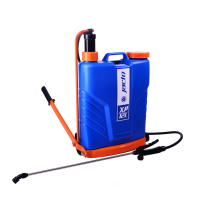XP
XP
TROUBLESHOOTING
PROCEDIMIENTOS PARA IDENTIFICACIÓN DE DEFICIENCIA DE PRESIÓN
∙ Put about 1/2 gallon of water in the tank.
While operating the pumping lever, look
into the tank to investigate the problem.
∙ Refer to the table and diagram below.
∙
Coloque aproximadamente 1/2 galón de
agua en el depósito.Accione la palanca y
observe en el interior del depósito como
se presenta el problema.
∙
Compare el problema con la descripción
de la tabla abajo.
PROBLEM
∙
DESCRIPCIÓN CAUSES
∙
CAUSAS
CORRECTIONS
∙
CORRECCIONES
Leakage through the cylinder upper
part.
Fuga de líquido por los orificios del
cilindro.
Worn or dried out piston cup.
Émbolo gastado o resecado.
Replace or lubricate the
piston cup.
Sustituya o lubrique el
émbolo.
After pumping and pressurizing the
chamber, as you operate the lever it
drops fast.
Después de bombear y cargar la
cámara, al accionar la palanca, ella
baja rápidamente.
Cylinder valve not sealing properly
due to wear or impurities.
Deficiencia de sellado por desgaste
o impurezas en la válvula
Clean or replace the
cylinder valve.
Limpie o sustituya la
válvula del cilindro.
After pumping and pressurizing the
chamber, the lever rises slowly when
released.
Después de bombear y cargar la cá-
mara, al soltar la palanca, ella sube
lentamente.
Chamber valve not sealing properly
due to wear or impurities.
Válvula de la cámara con defi-
ciencia de sellado por desgaste o
impurezas.
Clean or replace the
valve.
Limpie o sustituya la
válvula de la cámara.
09
16
8 ∙ The useless containers can be stored
temporarily in an appropriate place, until
final destination.
9 ∙ In the case of mid and large size contai-
ner (15, 25, and 50 gallons), after washing
with the appropriate volume (1/4 of the
total) and fitting the cap, roll it on the
ground for approximately 30 seconds.
10 ∙ Place the container in the upright po-
sition complete the agitation by moving
back and forth for approximately 30
seconds.
11 ∙ Empty the container by pouring the
rinse water into the spray tank.
12 ∙ REPEAT this operation two more times.
Totally empty the container by pouring
the rinse water in the sprayer tank.
13 ∙ The least amount quantity of rinse
water that remains in the container, from
one wash to the next, the better descon-
tamination will be.
14 ∙ For the best performance of the TRIPLE
WASH, do not use a water volume either
much lower or much higher than 1/4 of
the container capacity.
15 ∙ The TRIPLE WASH must be done IM-
MEDIATELY AFTER emptying the contai-
ner, during the preparation of the solution.
SOURCE - ANDEF (NATIONAL ASSOCIATION OF VEGETAL DEFENSE - BRAZIL)
8 ∙ Mientras se les destina un local defi-
nitivo, los envases inutilizados podrán ser
almacenados provisoriamente en un sitio
debidamente acondicionado.
9 ∙ En el caso de envases de tamaños me-
diano o grande (15, 20, and 50 galóns),
después del lavado, tápelos y hágalos rodar
en el suelo por unos 30 segundos.
10 ∙ Complete el proceso levantando alter-
nadamente las extremidades del envase,
apoyando una de ellas en el suelo. Hágalo
durante unos 30 segundos.
11 ∙
La retirada del agua del envase deberá
ser hecha de la misma manera que fue
hecha la retirada del producto. Hay que
colocarla en el tanque del pulverizador.
12 ∙ Repita dos veces las operaciones de
lavado. La última vez, vacíe totalmente el
envase y coloque el agua de los lavados en
el tanque del pulverizador.
13 ∙
Cuanto menor sea la cantidad de agua
de lavado que quede en el interior del en-
vase entre un lavado y otro, más perfecta y
completa será la descontaminación.
14 ∙
Para realizar el triple lavado no use
una cantidad de agua mayor o menor que
la equivalente a un cuarto del volumen
El triple lavado deberá ser realizado
inmediatamente después de haber vaciado
el envase para preparar el producto.
FUENTE: ASSOCIAÇÃO NACIONAL DE DEFESA VEGETAL - ANDEF/BRAZIL

